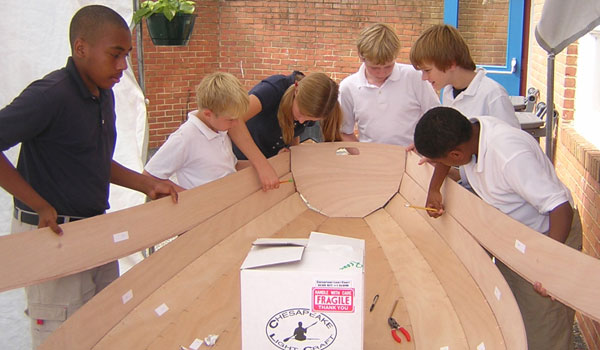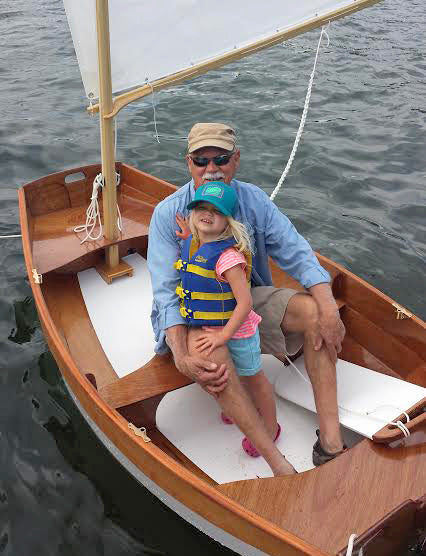Specifications
Performance
Stability
Speed
Cockpit Room
Payload
Ease of Construction

Overview
The Eastport Pram, with more than 1000 built, is one of the most popular small dinghies in the world. Classic good looks, stand-out performance, and ease of construction are hallmarks of this John C. Harris design.
After the pram was in production for several years, the design was updated in 2010. Now all Eastport Pram kits have the stitching holes, that hold the temporary copper stitches, drilled in all of the hull parts by our computerized machinery. Bulkhead locations are indicated by drill holes and machined "mortises" so there's no need for measuring, and the parts fit exactly every time.
We also updated the sailing rig in 2010. While the old rig is powerful and weatherly, the new rig is taller, bigger, and sports battens for a sleeker look and even more power on all points of sail. All this, and the Mark II mast is actually a foot shorter! The new rig may be retrofitted to older Eastport Prams. It’s simple to add the rig later if you just want a rowing boat to start with. In fact, the standard kit includes the daggerboard trunk, to make the conversion quick and easy months or years later!
We gave the Eastport Pram deep rocker for low wetted surface and to keep the transoms from dragging. The result is a boat that is as easy and satisfying to row as you can expect on such a short waterline. Used as a tender to a larger boat or kept at a dock, it's possible to undertake a long afternoon row around the local waters without breaking a sweat. Yes, an outboard or trolling motor may be fitted up to a maximum of 2-hp; the motor's weight should not exceed 30 lbs.
The Eastport Pram’s many joys are multiplied when you add the sailing rig. Not a clumsy add-on, the large standing-lug sail and efficient rudder and daggerboard convert the pram into a proper sailboat with enough real performance, upwind and down, to keep the most seasoned sailors interested. The 48-inch beam means that the likelihood of capsize is remote as long as the sheet is never tied down. This is the perfect craft in which to learn to sail, whether the crew is age 8 or 80.
Small tenders should be able to withstand heavy handling alongside the mothership or in the dinghy park. Planking is 6mm okoume throughout, with three 9mm frames and seats. There’s a big, deep skeg for tracking under tow. In addition to multiple layers of fiberglass on the bottom panel, there are two cypress rubbing strips on the bottom to take the abrasion of dragging on a beach. For added safety, permanent flotation tanks are built in beneath the seats.
For all its virtues, perhaps the neatest thing about the Eastport Pram is the ease of construction using CLC's patented LapStitch™ process. Not only does the hull go together in a single weekend, but everyone agrees that the lapstrake Eastport Pram is one of the most beautiful dinghies they've ever seen. It will take the patient novice only 40-50 hours to assemble the hull, with a little more part-time work for finishing. It is our easiest kit and perfect for families.
"Rowing from the center seat with the spoon-bladed oars moves the boat with a minimum effort, and it sails in just a ghost of a breeze. It punches through chop and boat wakes more easily than might be expected from such a light boat . . ." read the entire review - Good Old Boat Magazine, March 2001

What builders are saying
Main Gallery
Construction Gallery
Line Drawings
Videos
Frequently Asked Questions
Take One of our Boatbuilding Classes
We offer classes for many of the boats we sell. Teaching sites stretch from Maryland to Washington State and from Maine to California. Click here to find out more.
View ClassesNeed Help Building it?
We’re here to help with any questions you might have during the build process.









































































